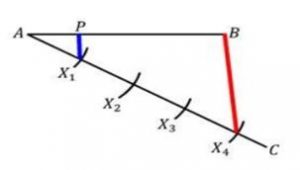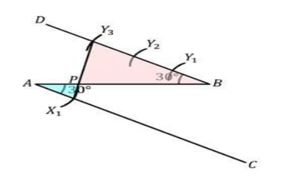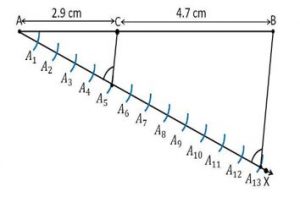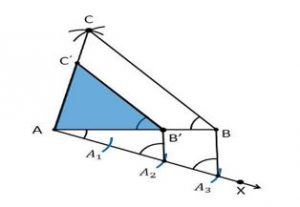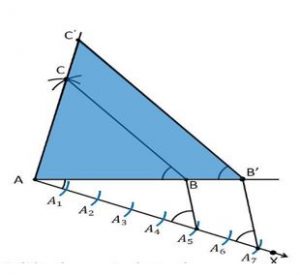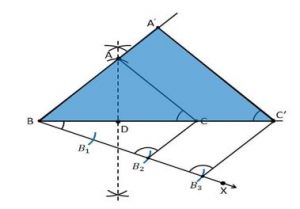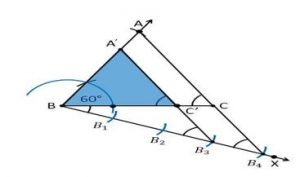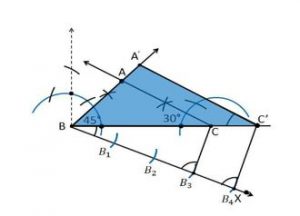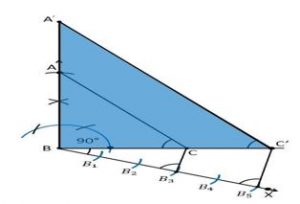Division of a Line Segment:
If we have to divide a line segment in particular ratio, then we can do it by measuring the length on the ruler and mark it on the line. But if we don’t have anything to measure then we can do it by using steps of construction.
Method 1:
AB is a line segment of 4 cm. Divide it in the ratio of 1:3 using a compass.
Steps of Construction:
Step 1: Draw a line AC of any length by making an acute angle with the given line segment AB.
Step 2: Using any small length on the compass mark 4 points of equal size on AC, so that AX1 = AX2 = AX3 = AX4. We are marking 4 points as we have to divide the line in the ratio of 1:3, so 1 + 3 = 4.
Step 3: Now join BX4.
Step 4: Draw a line from point X1 to line AB parallel to BX4, which intersects AB at point P.
Now AP: PB = 1:3.
Method 2:
(Alternative Method)
A line can also be divided by another method.
Steps of Construction:
Step 1: Draw a line AC with the acute angle with the line segment AB.
Step 2: Draw another line DB parallel to AC so that ∠BAX = ∠ADB
Step 3: Mark the points X1 (m = 1) on AC and Y1, Y2, Y3 (n = 3) on DB so that AX1 = BY1 = Y1Y2 = Y2Y3
Step 4: Join X1 Y3 so that it intersects line AB at P.
AP : PB = 1: 3
Construction of a Triangle similar to a given Triangle as per given Scale:
The scale factor is the ratio of the sides of the triangle given to the sides of the triangle to be made by the steps of construction.
Example : Draw a triangle similar to ∆ABC with its sides equal to 2/3 of the corresponding sides of the given triangle ABC. (Scale factor = 2/3 ) .
Steps of Construction
Step 1: Draw a line AX by making an acute angle with the line segment AB.
Step 2: Mark three points of equal size using a compass on the line AX. Points will be depending upon the scale factor as we have to mark the number of points which is greater in the scale factor. In the ratio of 2/3 ( 3 > 2).
Step 3: Join BX3 and draw a line from X2 parallel to BX3 to intersect AB at P.
Step 4: Draw a line parallel to BC from point P to intersect AC at Q.
Now ∆ APQ ~ ∆ ABC.
Remark: Here we have made a similar triangle which is smaller than the given triangle because the scale factor was 2/3. But if we have scale factor like 5/3 then we will make a bigger triangle then the given triangle by taking 5 points on the line).
EXERCISE 11.1
1. Draw a line segment of length 7.6 cm and divide it in the ratio 5 : 8. Measure the two parts.
Construction Procedure:
A line segment with a measure of 7.6 cm length is divided in the ratio of 5:8 as follows.
1. Draw line segment AB with the length measure of 7.6 cm
2. Draw a ray AX that makes an acute angle with line segment AB.
3. Locate the points i.e.,13 (= 5 + 8) points, such as A1, A2, A3, A4 …….. A13, on the ray AX such that it becomes AA1 = A1 A2 = A2 A3 and so on.
4. Join the line segment and the ray, BA13.
5. Through the point A5, draw a line parallel to BA13 which makes an angle equal to ∠AA13B
6. The point A5 which intersects the line AB at point C.
7. C is the point divides line segment AB of 7.6 cm in the required ratio of 5:8.
8. Now, measure the lengths of the line AC and CB. It is 2.9 cm and 4.7 cm respectively.
Justification: The construction of the given problem can be justified by proving that
AC/CB = 5/8
By construction, we have A5C || A13B. From Basic proportionality theorem for the triangle AA13B, we get AC/CB = AA5/ (A5 A13 ) ….. (1)
From the figure constructed, it is observed that AA5 and A5A13 contain 5 and 8 equal divisions of line segments respectively.
Therefore, it becomes AA5/(A5 A13) = 5/8 ..… (2)
Compare the equations (1) and (2), we obtain
AC/CB = 5/8
Hence, justified.
2. Construct a triangle of sides 4 cm, 5 cm and 6 cm and then a triangle similar to it whose sides are 2/3 of the corresponding sides of the first triangle.
Construction Procedure:
1. Draw a line segment AB which measures 4 cm, i.e., AB = 4 cm.
2. Take the point A as centre, and draw an arc of radius 5 cm.
3. Similarly, take the point B as its centre, and draw an arc of radius 6 cm.
4. The arcs drawn will intersect each other at point C.
5. Now, we obtained AC = 5 cm and BC = 6 cm and therefore ΔABC is the required triangle.
6. Draw a ray AX which makes an acute angle with the line segment AB on the
opposite side of vertex C.
7. Locate 3 points such as A1, A2, A3(as 3 is greater between 2 and 3) on line AX such that it becomes A A1 = A1,A2=A2A3.
8. Join the point BA3 and draw a line through A2which is parallel to the line BA3 that intersect AB at point B’.
9. Through the point B’, draw a line parallel to the line BC that intersect the line AC at C’.
10. Therefore, Δ AB’C’ is the required triangle.
Justification: The construction of the given problem can be justified by proving that
AB’ = (2/3) AB
B’C’ = (2/3) BC
AC’ = (2/3) AC
From the construction, we get B’C’ || BC
∴ ∠AB’C’ = ∠ABC (Corresponding angles)
In ΔAB’C’ and ΔABC,
∠ABC = ∠AB’C (Proved above)
∠BAC = ∠B’AC’ (Common)
∴ ΔAB’C’ ∼ ΔABC (From AA similarity criterion)
Therefore, AB/AB = (B’C’ )/BC = (AC’)/AC ….. (1)
∠A2AB’ =∠A3AB ( Common)
From the corresponding angles, we get,
∠AA2’ = ∠AA3B
Therefore, from the AA similarity criterion, we get
ΔAA2B’ and AA3B
So, (AB’)/AB=AA 2 /AA 3
Therefore, (AB’)/AB=2/3
From the equations (1) and (2), we get
(AB’)/AB=(B’ C’)/BC=(AC’)/AC=2/3
This can be written as
AB’ = (2/3) AB
B’C’ = (2/3) BC
AC’ = (2/3) AC
Hence, justified.
3. Construct a triangle with sides 5 cm, 6 cm and 7 cm and then another triangle whose sides are 7/5 of the corresponding sides of the first triangle
Construction Procedure:
1. Draw a line segment AB = 5 cm.
2. Take A and B as centre, and draw the arcs of radius 6 cm and 5 cm respectively.
3. These arcs will intersect each other at point C and therefore ΔABC is the required triangle with the length of sides as 5 cm, 6 cm, and 7 cm respectively.
4. Draw a ray AX which makes an acute angle with the line segment AB on the opposite side of vertex C.
5. Locate the 7 points such as A1, A2, A3, A4, A5, A6 A7 (as 7 is greater between 5 and 7), on line AX such that it becomes AA1 = A1 A2 = A2 A3 = A3 A4 = A4 A5 = A5 A6 = A6 A7
6. Join the points BA5 and draw a line from A7 to BA5 which is parallel to the line BA5 where it intersects the extended line segment AB at point B’.
7. Now, draw a line from B’ the extended line segment AC at C’ which is parallel to the line BC and it intersects to make a triangle.
8. Therefore, ΔAB’C’ is the required triangle.
Justification: The construction of the given problem can be justified by proving that
AB’ = ( 7/5 ) AB
B’C’ = ( 7/(5 )) BC
AC’ = ( 7/5 ) AC
From the construction, we get B’C’ || BC
∴ ∠AB’C’ = ∠ABC (Corresponding angles)
In ΔAB’C’ and ΔABC,
∠ABC = ∠AB’C (Proved above)
∠BAC = ∠B’AC’ (Common)
∴ ΔAB’C’ ∼ ΔABC (From AA similarity criterion)
Therefore, (A B)/(A B) = (B’ C’)/(B C)=(A C’)/(A C)
In Δ AA7B’ and Δ AA5B,
∠ A7 AB’ = ∠ A5 AB (Common)
From the corresponding angles, we get,
∠A A7B’ = ∠A A5B
Therefore, from the AA similarity criterion, we obtain
ΔAA2B’ and A A3B
So, AB/AB’ = AA5/AA7
Therefore, AB/AB’ = 5/7 ……. (2)
From the equations (1) and (2), we get
AB/AB’ = (B’C’)/BC=(AC’)/AC=7/5
This can be written as
AB’ = (7/5) AB
B’C’ = (7/5) BC
AC’ = (7/5) AC
Hence, justified.
4. Construct an isosceles triangle whose base is 8 cm and altitude 4 cm and then another triangle whose sides are 11/2 times the corresponding sides of the isosceles triangle.
Construction Procedure:
1. Draw a line segment BC with the measure of 8 cm.
2. Now draw the perpendicular bisector of the line segment BC and intersect at the point D
3. Take the point D as centre and draw an arc with the radius of 4 cm which intersect the perpendicular bisector at the point A
4. Now join the lines AB and AC and the triangle is the required triangle.
5. Draw a ray BX which makes an acute angle with the line BC on the side opposite to the vertex A.
6. Locate the 3 points B1, B2 and B3 on the ray BX such that BB1= B1B2 = B2B3
7. Join the points B2C and draw a line from B3 which is parallel to the line B2C where it intersects the extended line segment BC at point C’.
8. Now, draw a line from C’ the extended line segment AC at A’ which is parallel to the line AC and it intersects to make a triangle.
9. Therefore, ΔA’BC’ is the required triangle.
Justification: The construction of the given problem can be justified by proving that
A’B = (3/2) AB
BC’ = (3/2) BC
A’C’= (3/2) AC
From the construction, we get A’C’ || AC
∴ ∠ A’C’B = ∠ACB (Corresponding angles)
In ΔA’BC’ and ΔABC,
∠B = ∠B (common)
∠A’BC’ = ∠ACB
∴ ΔA’BC’ ∼ ΔABC (From AA similarity criterion)
Therefore, (AB)/AB = (BC’)/BC=(A’C’)/AC
Since the corresponding sides of the similar triangle are in the same ratio, it becomes
(AB)/AB = (BC’)/BC=(A’C’)/AC = 3/2
Hence, justified.
5. Draw a triangle ABC with side BC = 6 cm, AB = 5 cm and ∠ABC = 60°. Then construct a triangle whose sides are 3/4 of the corresponding sides of the triangle ABC.
Construction Procedure:
1. Draw a ΔABC with base side BC = 6 cm, and AB = 5 cm and ∠ABC = 60°.
2. Draw a ray BX which makes an acute angle with BC on the opposite side of vertex A.
3. Locate 4 points (as 4 is greater in 3 and 4), such as B1, B2, B3, B4, on line segment BX.
4. Join the points B4C and also draw a line through B3, parallel to B4C intersecting the line segment BC at C’.
5. Draw a line through C’ parallel to the line AC which intersects the line AB at A’.
6. Therefore, ΔA’BC’ is the required triangle.
Justification: The construction of the given problem can be justified by proving that
Since the scale factor is 3/4 , we need to prove
A’B = 3/4 AB
BC’ = 3/4 BC
A’C’= 3/4 AC
From the construction, we get A’C’ || AC
In ΔA’BC’ and ΔABC,
∴ ∠ A’C’B = ∠ACB (Corresponding angles)
∠B = ∠B (common)
∴ ΔA’BC’ ∼ ΔABC (From AA similarity criterion)
Since the corresponding sides of the similar triangle are in the same ratio, it becomes
Therefore, (A B)/AB = (BC’)/BC=(A’C’)/AC
So, it becomes (A B)/AB = (BC’)/BC=(A’C’)/AC = 3/4
Hence, justified.
6. Draw a triangle ABC with side BC = 7 cm, ∠ B = 45°, ∠ A = 105°. Then, construct a triangle whose sides are 4/3 times the corresponding sides of ∆ ABC.
To find ∠C:
Given: ∠ B = 45°, ∠A = 105°
We know that,
Sum of all interior angles in a triangle is 180°.
∠A + ∠B + ∠C = 180°
105° + 45° + ∠C = 180°
∠C = 180° − 150°
∠C = 30°
So, from the property of triangle, we get ∠C = 30°
Construction Procedure:
The required triangle can be drawn as follows.
1. Draw a ΔABC with side measures of base BC = 7 cm, ∠B = 45°, and ∠C = 30°.
2. Draw a ray BX makes an acute angle with BC on the opposite side of vertex A.
3. Locate 4 points (as 4 is greater in 4 and 3), such as B1, B2, B3, B4, on the ray BX.
4. Join the points B3C.
5. Draw a line through B4 parallel to B3C which intersects the extended line BC at C’.
6. Through C’, draw a line parallel to the line AC that intersects the extended line segment at C’.
7. Therefore, ΔA’BC’ is the required triangle.
Justification: The construction of the given problem can be justified by proving that
Since the scale factor is 4/3, we need to prove
A’B = 4/3 AB
BC’ = 4/3 BC
A’C’= 4/3 AC
From the construction, we get A’C’ || AC
In ΔA’BC’ and ΔABC,
∴ ∠A’C’B = ∠ACB (Corresponding angles)
∠B = ∠B (common)
∴ ΔA’BC’ ∼ ΔABC (From AA similarity criterion)
Since the corresponding sides of the similar triangle are in the same ratio, it becomes
Therefore, (AB)/AB = (BC’)/BC=(A’C’)/AC
So, it becomes (AB)/AB = (BC’)/BC=(A’C’)/AC = 4/3
Hence, justified.
7. Draw a right triangle in which the sides (other than hypotenuse) are of lengths 4 cm and 3 cm. Then construct another triangle whose sides are 5/3 times the corresponding sides of the given triangle.
Given: The sides other than hypotenuse are of lengths 4cm and 3cm. It defines that the sides are perpendicular to each other
Construction Procedure:
The required triangle can be drawn as follows.
1. Draw a line segment BC =3 cm.
2. Now measure and draw ∠= 90°
3. Take B as centre and draw an arc with the radius of 4 cm and intersects the ray at the point B.
4. Now, join the lines AC and the triangle ABC is the required triangle.
5. Draw a ray BX makes an acute angle with BC on the opposite side of vertex A.
6. Locate 5 such as B1, B2, B3, B4, on the ray BX such that such that BB1 = B1B2 = B2B3= B3B4 = B4B5
7. Join the points B3C.
8. Draw a line through B5 parallel to B3C which intersects the extended line BC at C’.
9. Through C’, draw a line parallel to the line AC that intersects the extended line AB at A’.
10. Therefore, ΔA’BC’ is the required triangle.
Justification: The construction of the given problem can be justified by proving that
Since the scale factor is 5/3, we need to prove
A’B = 5/3 AB
BC’ = 5/3 BC
A’C’= 5/3 AC
From the construction, we get A’C’ || AC
In ΔA’BC’ and ΔABC,
∴ ∠ A’C’B = ∠ACB (Corresponding angles)
∠B = ∠B (common)
∴ ΔA’BC’ ∼ ΔABC (From AA similarity criterion)
Since the corresponding sides of the similar triangle are in the same ratio, it becomes
Therefore, (AB)/AB = (BC’)/BC=(A’ C’)/AC
So, it becomes (AB)/AB = (BC’)/BC=(A’ C’)/AC = 5/3
Hence, justified.

